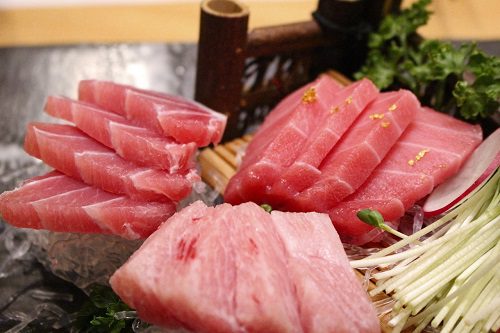Tuna is a type of fish that is popular around the world, particularly in sushi and other Japanese dishes. However, many people who have never tried tuna may wonder what it tastes like. In this article, we will explore the flavor profile of tuna, its texture, and its nutritional value.
What is Tuna?
Tuna is part of the Scombridae fish family, which includes mackerel, bonito, and other species of tuna. Tuna is found in warm and temperate waters around the world and is commonly caught for commercial purposes.
Tuna is an oily fish that has a firm, meaty texture. It is often served raw in sushi or cooked in a variety of dishes, such as grilled or seared tuna steaks.

What does Tuna Taste Like?
Tuna has a mild, slightly sweet flavor that is often described as meaty or robust. It is not as strongly flavored as other types of fish, such as salmon or mackerel, but it does have a distinctive taste that sets it apart from other seafood.
The flavor of tuna can vary depending on the type of tuna and the method of preparation. For example, bluefin tuna has a richer, more buttery flavor than yellowfin tuna. Additionally, cooked tuna may have a slightly different flavor profile than raw tuna.
Tuna Texture
Tuna has a firm, meaty texture that is similar to beef or chicken. It is not flaky like some other types of fish, and it does not fall apart easily. Instead, tuna has a dense, muscular texture that holds up well to cooking.
The texture of tuna can also vary depending on the cut and preparation method. For example, a tuna steak will have a different texture than a piece of tuna sashimi.

Tuna Nutrition
Tuna is a healthy food that is high in protein, vitamins, and minerals. It is also low in fat and calories, making it a great choice for people who are watching their weight or trying to eat a healthy diet.
One of the key nutritional benefits of tuna is its high protein content. A 3-ounce serving of tuna contains about 20 grams of protein, which is more than most other types of fish. Tuna is also a good source of omega-3 fatty acids, which have been shown to have a variety of health benefits, including reducing inflammation and improving heart health.
Tuna is also rich in vitamins and minerals. It is a good source of vitamin B12, which is important for maintaining healthy nerve cells and red blood cells. Tuna is also high in selenium, a mineral that helps to protect against oxidative damage and may reduce the risk of certain types of cancer.
Types of Tuna
There are several types of tuna that are commonly eaten around the world. The most popular types include:
- Bluefin Tuna – Bluefin tuna is a large, predatory fish that is prized for its rich, buttery flavor. It is often served raw in sushi or sashimi and is also used in a variety of cooked dishes.
- Yellowfin Tuna – Yellowfin tuna is a smaller species of tuna that is also known for its mild, slightly sweet flavor. It is often used in salads, sandwiches, and other cooked dishes.
- Albacore Tuna – Albacore tuna is a type of tuna that is commonly canned and used in sandwiches and salads. It has a milder flavor than other types of tuna and is often referred to as “white tuna.”
- Skipjack Tuna – Skipjack tuna is a smaller species of tuna that is often used in canned tuna products. It has a mild flavor and is less expensive than other types of tuna.
- Bigeye Tuna – Bigeye tuna is a large species of tuna that is similar in flavor to bluefin tuna. It is often used in sushi and sashimi and is also cooked in a variety of dishes.
Each type of tuna has its own unique flavor profile and texture, making it important to choose the right type of tuna for the dish you are making.

Preparing Tuna
Tuna can be prepared in a variety of ways, depending on the desired flavor and texture. Some common methods of preparing tuna include:
- Grilling – Grilling is a popular way to prepare tuna steaks. The high heat helps to sear the outside of the fish, giving it a slightly smoky flavor and crispy texture.
- Searing – Searing is a method of cooking that involves quickly cooking the outside of the fish over high heat. This method is often used to prepare tuna for sushi and sashimi dishes.
- Poaching – Poaching is a gentle cooking method that involves simmering the fish in liquid. This method can help to keep the fish moist and tender.
- Canning – Tuna is commonly canned and used in sandwiches, salads, and other dishes. Canned tuna is often mixed with mayonnaise or other ingredients to create a flavorful filling.
- Raw – Raw tuna is a popular ingredient in sushi and sashimi dishes. The fish is sliced thinly and served with soy sauce and wasabi.
Conclusion
Tuna is a delicious and versatile fish that is enjoyed around the world. Its mild, meaty flavor and firm texture make it a popular choice for sushi, salads, and other dishes. With its high protein content and nutritional benefits, tuna is also a healthy addition to any diet. Whether grilled, seared, or served raw, tuna is sure to satisfy even the most discerning seafood lover’s taste buds.

